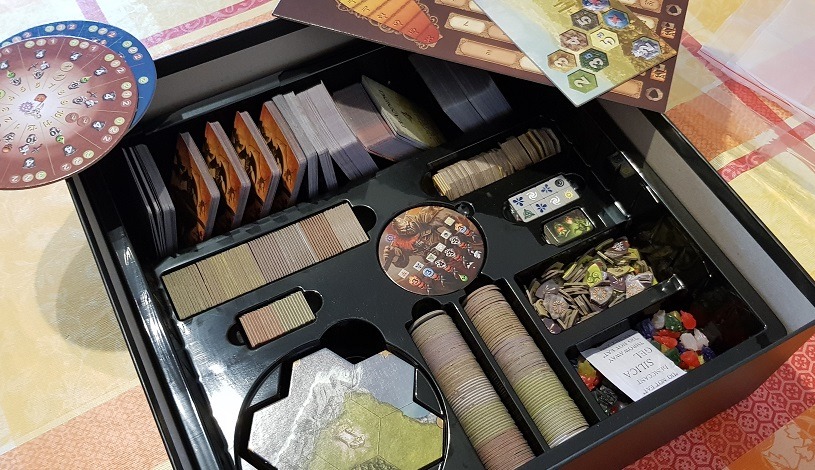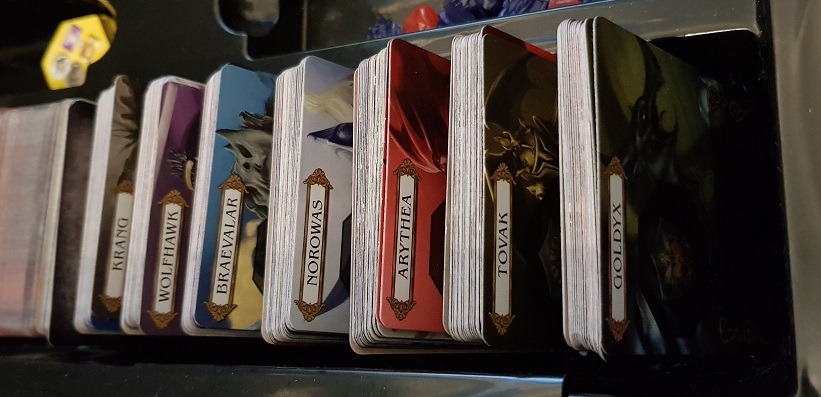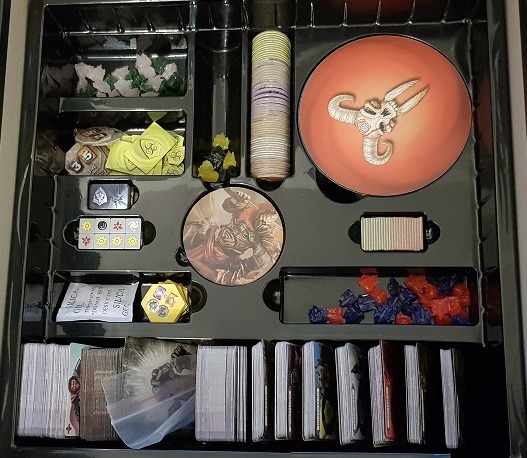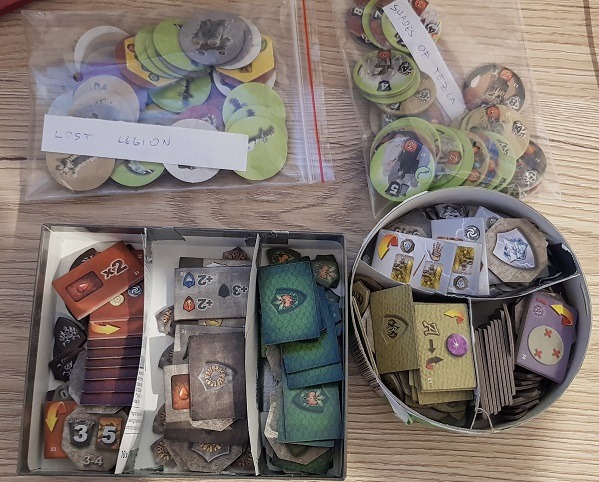Mage Knight is a big game. When you first open the box, you’ll likely be overwhelmed by the sheer number of components, especially if you don’t have a lot of experience with such big games. While the original insert is decent, there are further benefits to organizing Mage Knight Ultimate Edition components.
What is Mage Knight?
Mage Knight is a very complex board game, best-experienced solo or in small-player numbers. You play as a powerful wizard/warrior, traveling around a fantasy world, filled with monsters that need to be killed, settlements to interact with, and your own agendas, like capturing cities.
By gameplay mechanics, it’s a deck-building game. You start with a basic deck (seven characters are available in the ultimate edition), which you improve during the game. Managing your deck is key, as most of your available actions (like movement and combat) come from it. You can also use your special skills and command units.
Complementing the base game were several expansions, which added new heroes, action cards, enemies, scenarios, and much more. The Ultimate edition is a revised compilation of the base game and all the expansions.
For more information about the game, I have already dedicated plenty of articles to it on this website. Explore the navigation menu on the top or follow the links in this article for further reading.
Read my review of Mage Knight Ultimate Edition
Why should you bother with Organizing Mage Knight Ultimate Edition components?
The plastic insert that comes with the ultimate edition is not bad. Contrarily, every component type has its own space: trays for cards, separated by character, action cards, and wounds. There are trays for crystals, skill tokens, enemy tokens, terrain tiles, dice, and expansion tokens.
But, there are two problems with it. The first, minor one is that trays are unmarked, nor are there any hints on how to organize them in the manual. But OK, I guess they assumed someone who buys Mage Knight has above-average intelligence and can figure it out by himself. Or is at least wise enoguh to google it. :).
Second, a slightly larger problem is that all the same tokens go in the same tray. Let me give you an example, so you see what I mean by that.

There is a tray for skill tokens for all seven characters. All the tokens are in the same tray. You normally need only a couple of skill token sets. That means sorting them every time you need them and then also when putting them back together. They are very small and like to spill out inside the tray, making them very fiddly to handle.
A similar situation is with enemy tokens and character marking shields. All crystals are mixed together in one tray. Even components from the base game and expansions are mixed together. Should you want to play only with action cards and enemies from the base game, you’ve got a lot of sorting to do.
This is a problem because of the long set-up and tear-down time for Mage Knight. There are a lot of components to prepare and even if you have every token ready, it can take time. Even longer, if you have to sort components as you take them out. Then everything repeats itself when you begin to store the items back into the box.
How to organize components then?
The most important thing is to separate components by character. You want to have everything that belongs to a character separated from other characters. If you want to play as Tovak, you know what cards, skill tokens, and shields to grab and you have them ready in a minute.

First, the cards. Obviously, have the deck for each of the heroes prepared. His/her “header” card, action cards, and cards with skills explained. There are seven smaller trays for decks – these are meant for this purpose.
Second, skill tokens, large shields, and small marking shields. Store these together, separated for each character. You can use a plastic bag, but I prefer a box, so you don’t have to spill them out. I made mine out of cardboard boxes I had lying around and duct tape in a matter of minutes. This way I can open the box and keep it on the table while I play.
You can also put your order tokens into this mix as well. I’ve decided to leave them in the original trays.
This process frees up a lot of trays in the insert. You can now use those trays to sort out other components. I’ve separated the crystals into three trays: gold+black, white+green and red+blue. This way I can keep the big box beside me and they are in easy reach during the play.

What about the expansions?
If you want to keep the expansions separated or not is your decision. While the enemy token trays are a bit awkward (stacking of tokens is awkward, rather), there are two of them. Incidentally, you can put all the base game enemies into one and all expansions enemy tokens into the second.

Action cards and unit cards are all conveniently marked so that the ones from expansions can be differentiated. The same goes for terrain tiles.
What I’ve done: I’ve separated all of them. Basically, I only played with base game components for the first couple of times, then I slowly started to add more components, starting with units and action cards. I will add enemy tokens and terrain tiles next. When I feel comfortable, that is.
Further reading
Mage Knight: Folded Space Insert Review
Laserox Insert for Mage Knight Ultimate Edition Review
Conclusion
Hopefully, this article gave you some ideas on how to organize Mage Knight Ultimate Edition better. You don’t need to buy any fancy inserts or boxes (although there are plenty available – see links above); you can do it all by yourself with a bit of imagination and creativity. It will vastly improve your set-up and tear-down times and leave you with more time to actually play the game.
Do you like what you just read? Consider subscribing for more content:

Thank you so much for this!
Always nice to hear someone found my article useful. 🙂
Hi, thanks for sharing, love the site. Also a big fan of mage knight.
I use the broken token insert on the base game box which can hold all expansions. I prefer this insert since it allows me to leave a lot of components (enemy tokens, all cards, crystals) in the box to save table space and setup more quickly.
I love your idea but if you are open to invest into the game, broken token insert + card sleeves are the way to go.
Thanks for the comment.
Third-party solutions (inserts and sleeves) are great, but I wanted to focus more on the things you can do yourself. (And for free.)
I don’t know what magic did you use here, since this a new version of the insert, with more space for cards. There is absolutely not enough space to put all skill tokens in the skill token trey. I have 3 or so remaining, if I tried to push them in i would ruin them. Same with monster treys, there is also slightly less space than it should be. I ‘ve read these same complaints from multiple people, so I have no idea how did you manage to put them all in (I’m talking about pre-organizing image)
They all fit nicely, there was no force needed. The only explanation I can think of is that the insert was changed for the latest edition. But then again, why would they do that?
Could you provide a picture? Now I’m curious to find out what the mystery is here. 🙂